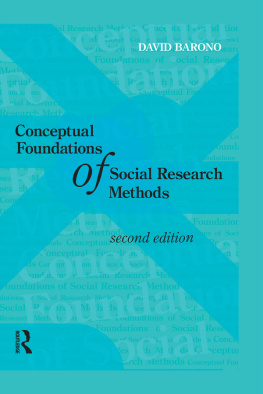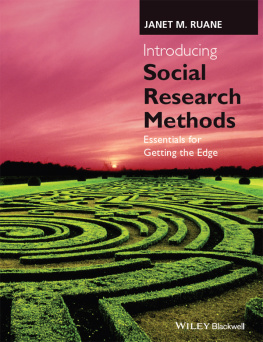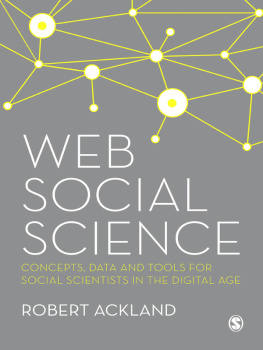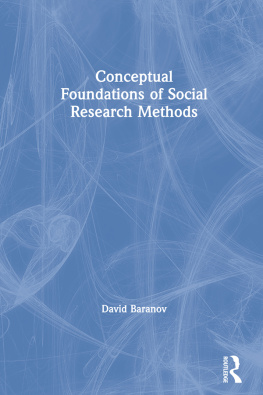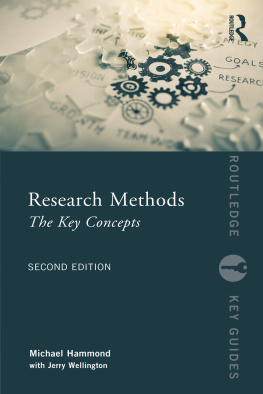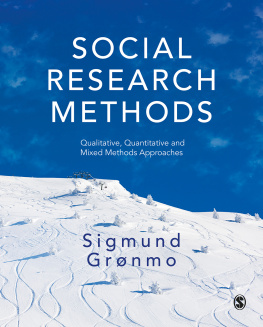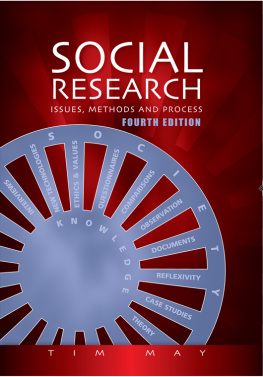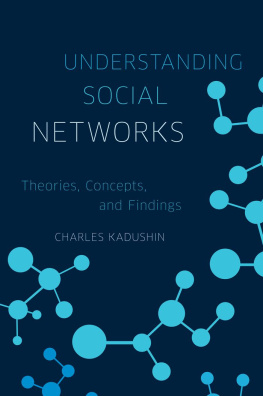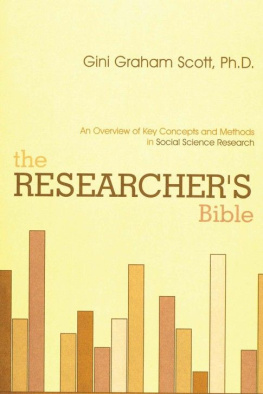C ONCEPTUAL F OUNDATIONS OF S OCIAL R ESEARCH M ETHODS
First published 2012 by Paradigm Publishers
Published 2016 by Routledge
2 Park Square, Milton Park, Abingdon, Oxon OX14 4RN
711 Third Avenue, New York, NY 10017, USA
Routledge is an imprint of the Taylor & Francis Group, an informa business
Copyright 2012, Taylor & Francis.
All rights reserved. No part of this book may be reprinted or reproduced or utilised in any form or by any electronic, mechanical, or other means, now known or hereafter invented, including photocopying and recording, or in any information storage or retrieval system, without permission in writing from the publishers.
Notice:
Product or corporate names may be trademarks or registered trademarks, and are used only for identification and explanation without intent to infringe.
Library of Congress Cataloging-in-Publication Data
Baronov, David.
Conceptual foundations of social research methods / David Baronov. 2nd ed.
p. cm.
Includes bibliographical references and index.
ISBN 978-1-59451-737-2 (hardcover : alk. paper) ISBN 978-1-59451-738-9 (pbk. : alk. paper)
1. Social sciencesResearch Methodology. 2. Social
sciences Research Philosophy. I. Title.
H62.B337 2012
300.72 dc23
2012010971
Designed and Typeset by Straight Creek Bookmakers.
ISBN 13: 978-1-59451-737-2 (hbk)
ISBN 13: 978-1-59451-738-9 (pbk)
Contents
The reviews and feedback from colleagues and students regarding the content and style of presentation in the first edition of this text have been highly favorable. For this reason, I have opted to retain my basic approach and to use this revision primarily to further supplement the existing material. The major revision for this text is the addition of a chapter on pragmatism. Pragmatic social research remains an influential current within the social sciences and education. Introductory-level texts that treat the genre as a whole, rather than introductions limited to considerations of Peirce, James, or Dewey, are scant. My effort here is to introduce the reader to pragmatism (and its variants) within the context of competing research methods across the social sciences and education more generally.
Furthermore, in the first edition in 2004, each chapter ended with a short list of recommended further reading. These readings were selected not because they necessarily represented the latest, cutting-edge interpretations. Rather, these selections offered compelling overviews of varying approaches to social research in greater depth and detail than it was possible to provide in this text. For example, while this text introduces and contextualizes key debates, many of the recommended readings allow students to more narrowly focus on core aspects of these debates. The essays, therefore, spanned from the early 1960s through 2001. For this second edition, with this same purpose in mind, I have revisited and expanded the recommended readings for each chapter to include materials published since the first edition came out.
These are the major revisions to the first edition.
I owe a great debt to many students, friends, and colleagues whose insights and inspiration have shaped my understanding of the core issues explored in this book. Terence Hopkins, Dale Tomich, and Kelvin Santiago Valles were among those who first encouraged me to pursue the disturbing entanglements beneath the surface of methodological issues in the social sciences. Their advice, suggestions, and criticisms continue to prod my interest in the field. Good fortune has allowed me to further consider the implications of these issues through conversations and exchanges with a number of talented colleagues, including Erik Prez Velasco, Gladys Jimnez Muoz, Ruth L. Harris, Robert Brimlow, Jos Toro Alfonso, Khaldoun Samman, Barbara Lowe, and Mark Gaskill.
I am especially grateful for the contributions of Timothy Madigan and Daniel R. Shaffer, whose reviews and comments on earlier drafts of the manuscript were critical for the development of this work. I have also greatly benefited from the skillful assistance of my publisher, Dean Birkenkamp. His encouragement was essential for seeing this project through to its completion and guiding me along the path.
In 2002, I was the recipient of a St. John Fisher College Faculty Development Grant. This award provided me with critical resources and financial assistance for the completion of this project.
Lastly, I wish to acknowledge the essential contribution of Mrs. Druian, without whom this book would never have been possible.
By now the routine is a familiar one. Each fall, anxious throngs of high school graduatesand a growing number of adult returning studentsmake their way onto college campuses. The new arrivals face the formidable tasks of working toward graduation and preparing for a career. This requires, early on, selecting a major. The major will clarify graduation requirements and provide a sense of career options. Ominously, the selection of a major will also lock unsuspecting students into a mind-set and a framework of analysis that will tell them, quite literally, what and how to think, the nature of truth, and which questions are permitted and which are not.
Traditionally, college subjects are grouped into three brancheshumanities, physical sciences, and social sciences. Each encompasses a distinct subject matter and each explores this subject matter through a unique battery of methods. The humanities study forms of creative human expression (art, literature, music, etc.) and deploy various interpretive methods. The physical sciences study the natural world and rely upon the so-called scientific method. The social sciences study the social world (forms of human interaction and individual behavior) and turn to variations of the scientific method. Curiously, in the course of ones undergraduate education, while there is a good deal of recognition and discussion about the distinct subject matters that separate the three branches, little is said of the differences between the branches methods.
The consequences of this oversight can be insidious. Consider the experiences of Fawziyya, Lisa, and Manuelthree seventeen-year-olds who were among those arriving on campus last fall. As it happened, all had suffered the painful loss of their mother to cancer in the past year. All three were, of course, deeply affected by their mothers deaths and these personal tragedies dramatically shaped how they chose a college major. Fawziyya wanted to understand the nature of her mothers illness so she could help others. She chose to study biology. Lisa was curious why, despite the dangers, certain cancer-related practices (such as smoking) are so prevalent across society. She chose to study sociology. Manuel wanted to better appreciate the spiritual and emotional transformation that his mother experienced while dying of cancer. He chose to study literature. Each struggled to come to terms with a deeply personal loss and each chose a separate path. In the end, a common tragedya mothers death from cancerresulted in three distinct forms of knowledge and insight.
Directly tied to these distinct forms of knowledge and insight are methods of analysis that determine how one sees and understands the world. These are the implicit anchors (and the ideology) defining the boundaries of any field. For this reason, they are crucial and, for this reason, they are dangerous. In light of this, a rather absurd situation prevails today. In the course of an undergraduate education, each student confronts a set of fundamental assumptions and presuppositions concerning the nature of truth attached to his or her field of study. However, with rare exception, there is little sustained discussion of these assumptions and presuppositions in comparison with other fields. As a result, students pursue truth within the confines of their field and become the unwitting transmitters of its silent ideology. The purpose of this book is to explicitly address the unexplored assumptions and hidden ideologies that lurk beneath a college education. While there is a particular focus on the social sciences (in particular sociology), there is also much to be gained by those in the humanities and the physical sciences who wish to better understand the role of unspoken premises within their own fields.

